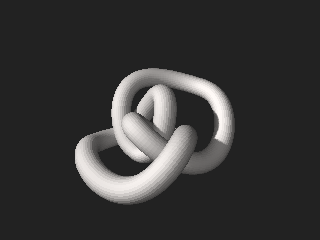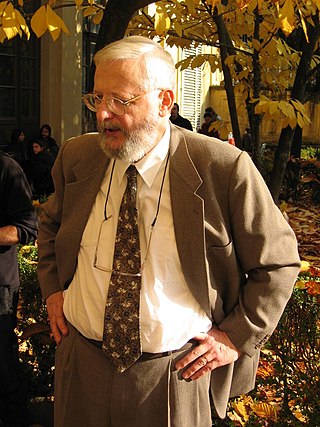Higher-dimensional categories
A first step towards defining higher dimensional algebras is the concept of 2-category of higher category theory, followed by the more 'geometric' concept of double category. [1] [2] [3]
A higher level concept is thus defined as a category of categories, or super-category, which generalises to higher dimensions the notion of category – regarded as any structure which is an interpretation of Lawvere's axioms of the elementary theory of abstract categories (ETAC). [4] [5] Ll.
, [6] [7] Thus, a supercategory and also a super-category, can be regarded as natural extensions of the concepts of meta-category, [8] multicategory, and multi-graph, k-partite graph, or colored graph (see a color figure, and also its definition in graph theory).
Supercategories were first introduced in 1970, [9] and were subsequently developed for applications in theoretical physics (especially quantum field theory and topological quantum field theory) and mathematical biology or mathematical biophysics. [10]
Other pathways in higher-dimensional algebra involve: bicategories, homomorphisms of bicategories, variable categories (aka, indexed, or parametrized categories), topoi, effective descent, and enriched and internal categories.

Category theory is a general theory of mathematical structures and their relations that was introduced by Samuel Eilenberg and Saunders Mac Lane in the middle of the 20th century in their foundational work on algebraic topology. Category theory is used in almost all areas of mathematics. In particular, numerous constructions of new mathematical objects from previous ones that appear similarly in several contexts are conveniently expressed and unified in terms of categories. Examples include quotient spaces, direct products, completion, and duality.

In mathematics, topology is concerned with the properties of a geometric object that are preserved under continuous deformations, such as stretching, twisting, crumpling, and bending; that is, without closing holes, opening holes, tearing, gluing, or passing through itself.

Algebraic topology is a branch of mathematics that uses tools from abstract algebra to study topological spaces. The basic goal is to find algebraic invariants that classify topological spaces up to homeomorphism, though usually most classify up to homotopy equivalence.
The following outline is provided as an overview of and guide to category theory, the area of study in mathematics that examines in an abstract way the properties of particular mathematical concepts, by formalising them as collections of objects and arrows, where these collections satisfy certain basic conditions. Many significant areas of mathematics can be formalised as categories, and the use of category theory allows many intricate and subtle mathematical results in these fields to be stated, and proved, in a much simpler way than without the use of categories.
In mathematics, Grothendieck's Galois theory is an abstract approach to the Galois theory of fields, developed around 1960 to provide a way to study the fundamental group of algebraic topology in the setting of algebraic geometry. It provides, in the classical setting of field theory, an alternative perspective to that of Emil Artin based on linear algebra, which became standard from about the 1930s.
In mathematics, the Seifert–Van Kampen theorem of algebraic topology, sometimes just called Van Kampen's theorem, expresses the structure of the fundamental group of a topological space in terms of the fundamental groups of two open, path-connected subspaces that cover . It can therefore be used for computations of the fundamental group of spaces that are constructed out of simpler ones.
In mathematics, the Eckmann–Hilton argument is an argument about two unital magma structures on a set where one is a homomorphism for the other. Given this, the structures are the same, and the resulting magma is a commutative monoid. This can then be used to prove the commutativity of the higher homotopy groups. The principle is named after Beno Eckmann and Peter Hilton, who used it in a 1962 paper.

Francis William Lawvere was an American mathematician known for his work in category theory, topos theory and the philosophy of mathematics.
In mathematics, and especially in homotopy theory, a crossed module consists of groups and , where acts on by automorphisms (which we will write on the left, , and a homomorphism of groups
In mathematics, higher category theory is the part of category theory at a higher order, which means that some equalities are replaced by explicit arrows in order to be able to explicitly study the structure behind those equalities. Higher category theory is often applied in algebraic topology, where one studies algebraic invariants of spaces, such as their fundamental weak ∞-groupoid.

André Joyal is a professor of mathematics at the Université du Québec à Montréal who works on category theory. He was a member of the School of Mathematics at the Institute for Advanced Study in 2013, where he was invited to join the Special Year on Univalent Foundations of Mathematics.
This is a timeline of category theory and related mathematics. Its scope is taken as:
In mathematics, a 2-group, or 2-dimensional higher group, is a certain combination of group and groupoid. The 2-groups are part of a larger hierarchy of n-groups. In some of the literature, 2-groups are also called gr-categories or groupal groupoids.
In mathematics, especially in higher-dimensional algebra and homotopy theory, a double groupoid generalises the notion of groupoid and of category to a higher dimension.
In mathematics, R-algebroids are constructed starting from groupoids. These are more abstract concepts than the Lie algebroids that play a similar role in the theory of Lie groupoids to that of Lie algebras in the theory of Lie groups..

Ronald Brown is an English mathematician. Emeritus Professor in the School of Computer Science at Bangor University, he has authored many books and more than 160 journal articles.
Myles Tierney was an American mathematician and Professor at Rutgers University who founded the theory of elementary toposes with William Lawvere.
In algebraic topology, the fundamental groupoid is a certain topological invariant of a topological space. It can be viewed as an extension of the more widely-known fundamental group; as such, it captures information about the homotopy type of a topological space. In terms of category theory, the fundamental groupoid is a certain functor from the category of topological spaces to the category of groupoids.
[...] people still obstinately persist, when calculating with fundamental groups, in fixing a single base point, instead of cleverly choosing a whole packet of points which is invariant under the symmetries of the situation, which thus get lost on the way. In certain situations it is much more elegant, even indispensable for understanding something, to work with fundamental groupoids with respect to a suitable packet of base points, [,,,]
In mathematics, nonabelian algebraic topology studies an aspect of algebraic topology that involves higher-dimensional algebras.
Mikhail Kapranov, is a Russian mathematician, specializing in algebraic geometry, representation theory, mathematical physics, and category theory. He is currently a professor of the Kavli Institute for the Physics and Mathematics of the Universe at the University of Tokyo.






